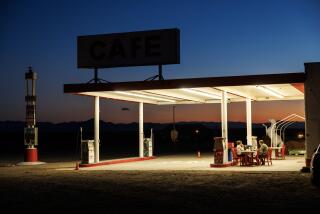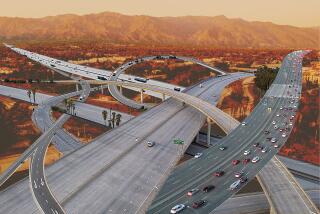ROUTE 66 : ‘They Fell in Love With Adventure’
- Share via
AMBOY, Calif. — For 53 years at this fleck in the Mojave Desert, Buster Burris and Roy’s Motel-Cafe have held out against drought, gas embargoes, economic oscillations of three wars--and the dismantling of Route 66.
In 1952, he had 100 people working 24-hour days on food, lodging and engine changes. “They would go until exhausted, sleep a few hours and come back on duty,” says lined, sun-dried Burris, 83.
Then Interstate 40 looped around Amboy, and now there’s just Burris and wife Beth, no mechanic on duty and only two dozen lunches served on a good day.
Burris says too many people look back on Route 66 the way men recall military service: Only remembering the good times.
“On Route 66 they fell in love with the adventure,” Burris explains. “I remember the Model A’s, Model Ts and early Plymouths with water bags hanging all over ‘em.
“To get here, some spent two weeks on the road covering only 20 miles a day. We used to say that one mattress on top of the car meant a poor Oakie, two mattresses was a rich Oakie.”
Burris won’t leave Roy’s Motel-Cafe. He says new reverence for Route 66 has business looking up. Some motorists are tugged by a sense of history. Others say police usually patrol Interstate 40 for speeders, leaving Route 66 free for 100-m.p.h. cruising.
His worst of times?
“Before the road was striped, I’d go out to three wrecks a day, mostly cars that collided on narrow wooden bridges. I’d carry a saw in the truck to cut people out from 8-by-8 redwood beams.”
His best of times?
“People I met as they headed west who took the trouble to come back, years later to tell me: ‘Well, I made it.’ Now, with new interest in Route 66, we’re being visited by their children.”
More to Read
Sign up for The Wild
We’ll help you find the best places to hike, bike and run, as well as the perfect silent spots for meditation and yoga.
You may occasionally receive promotional content from the Los Angeles Times.






